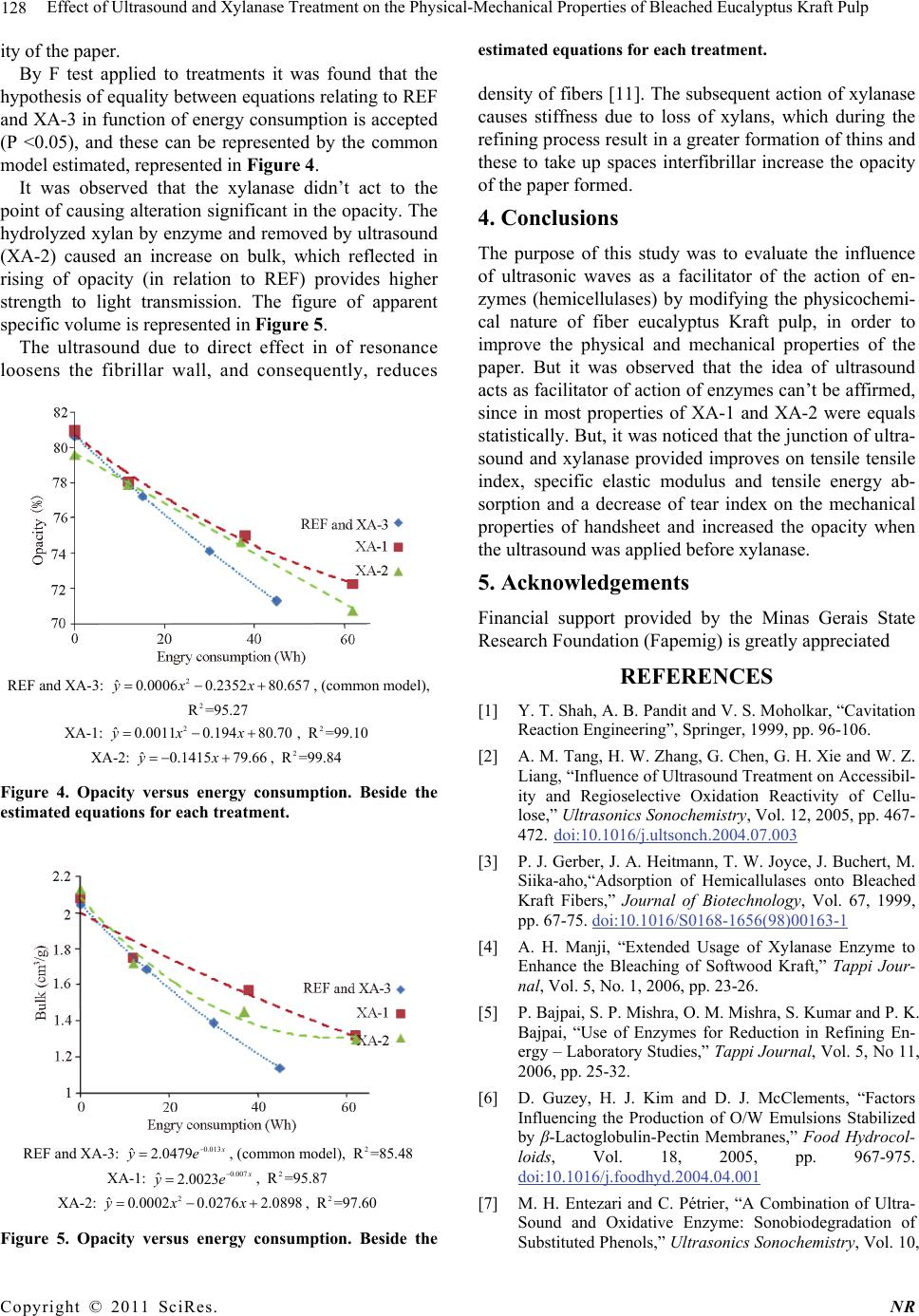
128 Effect of Ultrasound and Xylanase Treatment on the Physical-Mechanical Properties of Bleached Eucalyptus Kraft Pulp
ity of the paper.
By F test applied to treatments it was found that the
hypothesis of equality between equations relating to REF
and XA-3 in function of energy consumption is accepted
(P <0.05), and these can be represented by the common
model estimated, represented in Figure 4.
It was observed that the xylanase didn’t act to the
point of causing alteration significant in the opacity. The
hydrolyzed xylan by enzyme and removed by ultrasound
(XA-2) caused an increase on bulk, which reflected in
rising of opacity (in relation to REF) provides higher
strength to light transmission. The figure of apparent
specific volume is represented in Figure 5.
The ultrasound due to direct effect in of resonance
loosens the fibrillar wall, and consequently, reduces
Figure 4. Opacity versus energy consumption. Beside the
estimated equations for each treatment.
Figure 5. Opacity versus energy consumption. Beside the
estimated equations for each treatment.
density of fibers [11]. The subsequent action of xylanase
causes stiffness due to loss of xylans, which during the
refining process result in a greater formation of thins and
these to take up spaces interfibrillar increase the opacity
of the paper formed.
4. Conclusions
The purpose of this study was to evaluate the influence
of ultrasonic waves as a facilitator of the action of en-
zymes (hemicellulases) by modifying the physicochemi-
cal nature of fiber eucalyptus Kraft pulp, in order to
improve the physical and mechanical properties of the
paper. But it was observed that the idea of ultrasound
acts as facilitator of action of enzymes can’t be affirmed,
since in most properties of XA-1 and XA-2 were equals
statistically. But, it was noticed that the junction of ultra-
sound and xylanase provided improves on tensile tensile
index, specific elastic modulus and tensile energy ab-
sorption and a decrease of tear index on the mechanical
properties of handsheet and increased the opacity when
the ultrasound was applied before xylanase.
REF and XA-3: , (common model),
2
ˆ0.00060.2352 80.657yx x
2
R =95.27
XA-1: ,
2
ˆ0.00110.19480.70yxx 2
R =99.10
XA-2: ,
ˆ0.141579.66yx 2
R =99.84
5. Acknowledgements
Financial support provided by the Minas Gerais State
Research Foundation (Fapemig) is greatly appreciated
REFERENCES
[1] Y. T. Shah, A. B. Pandit and V. S. Moholkar, “Cavitation
Reaction Engineering”, Springer, 1999, pp. 96-106.
[2] A. M. Tang, H. W. Zhang, G. Chen, G. H. Xie and W. Z.
Liang, “Influence of Ultrasound Treatment on Accessibil-
ity and Regioselective Oxidation Reactivity of Cellu-
lose,” Ultrasonics Sonochemistry, Vol. 12, 2005, pp. 467-
472. doi:10.1016/j.ultsonch.2004.07.003
[3] P. J. Gerber, J. A. Heitmann, T. W. Joyce, J. Buchert, M.
Siika-aho,“Adsorption of Hemicallulases onto Bleached
Kraft Fibers,” Journal of Biotechnology, Vol. 67, 1999,
pp. 67-75. doi:10.1016/S0168-1656(98)00163-1
REF and XA-3: 0.013
ˆ2.0479
ye
, (common model),
2
R=85.48
XA-1: 0.007
ˆ2.0023
ye
2
,
2
R =95.87
2
XA-2: ,
ˆ0.00020.0276 2.0898yxx
R =97.60
[4] A. H. Manji, “Extended Usage of Xylanase Enzyme to
Enhance the Bleaching of Softwood Kraft,” Tappi Jour-
nal, Vol. 5, No. 1, 2006, pp. 23-26.
[5] P. Bajpai, S. P. Mishra, O. M. Mishra, S. Kumar and P. K.
Bajpai, “Use of Enzymes for Reduction in Refining En-
ergy – Laboratory Studies,” Tappi Journal, Vol. 5, No 11,
2006, pp. 25-32.
[6] D. Guzey, H. J. Kim and D. J. McClements, “Factors
Influencing the Production of O/W Emulsions Stabilized
by β-Lactoglobulin-Pectin Membranes,” Food Hydrocol-
loids, Vol. 18, 2005, pp. 967-975.
doi:10.1016/j.foodhyd.2004.04.001
[7] M. H. Entezari and C. Pétrier, “A Combination of Ultra-
Sound and Oxidative Enzyme: Sonobiodegradation of
Substituted Phenols,” Ultrasonics Sonochemistry, Vol. 10,
Copyright © 2011 SciRes. NR